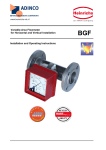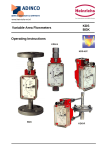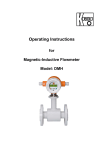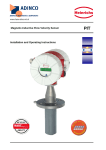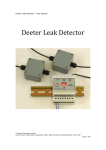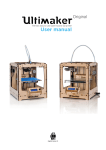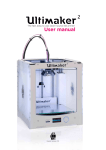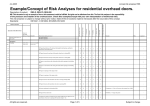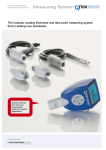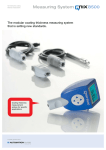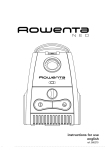Download Installation and Operating Instructions
Transcript
www.heinrichs-mt.nl Electromagnetic Flowmeter Installation and Operating Instructions EP Heinrichs Messtechnik EP Installation and Operating Instructions Table of contents 1 SAFETY ADVISORIES ................................................................................................................... 4 1.1 Installation, commissioning, operating personnel ................................................................................ 4 1.2 Intended purpose ..................................................................................................................................... 4 1.3 Packaging, storaging, transport............................................................................................................. 4 1.4 Returning the device for repair and servicing....................................................................................... 4 2 IDENTIFICATION ........................................................................................................................... 5 2.1 Supplier/manufacturer ............................................................................................................................ 5 2.2 Product type ............................................................................................................................................. 5 2.3 Product name ........................................................................................................................................... 5 2.4 Issue date ................................................................................................................................................... 5 2.5 Version no................................................................................................................................................. 5 2.6 Designation/rating plate ......................................................................................................................... 5 3 APPLICATIONS ............................................................................................................................. 6 4 OPERATIONAL MODE AND SYSTEM DESIGN .......................................................................... 6 4.1 Operational mode .................................................................................................................................... 6 4.2 System design .......................................................................................................................................... 6 4.2.1 Integral mount transmitter .............................................................................................................. 7 4.2.2 Remote mount transmitter .............................................................................................................. 7 5 PERFORMANCE CHARACTERISTICS ........................................................................................ 8 5.1 Measuring accuracy ................................................................................................................................ 8 5.1.1 Measured error ............................................................................................................................... 8 5.1.2 Repeatability................................................................................................................................... 8 5.1.3 Reference conditions ...................................................................................................................... 8 5.2 Fluid conductivity ..................................................................................................................................... 8 5.3 Influence of ambient temperature.......................................................................................................... 8 5.4 Influence of fluid temperature................................................................................................................ 8 5.5 Materials .................................................................................................................................................... 9 5.5.1 Wetted parts.................................................................................................................................... 9 5.5.2 Non-wetted parts ............................................................................................................................ 9 6 INSTALLATION/CONDITIONS FOR USE ..................................................................................... 9 6.1 Receipt of goods and transport............................................................................................................... 9 6.1.1 Receipt of goods ............................................................................................................................. 9 6.1.2 Transport ...................................................................................................................................... 10 6.2 Installation conditions ........................................................................................................................... 10 6.2.1 Long pipe systems ........................................................................................................................ 11 6.2.2 Pumps ........................................................................................................................................... 11 6.2.3 Bypass .......................................................................................................................................... 11 6.2.4 Flow tube lining ........................................................................................................................... 11 6.3 Installation ............................................................................................................................................. 11 6.3.1 Installation in pipes with larger nominal sizes ............................................................................. 11 6.3.2 Horizontal and vertical installation............................................................................................... 11 6.3.3 Installation examples .................................................................................................................... 12 6.3.4 Grounding..................................................................................................................................... 13 6.3.5 Torques for screws and bolts ........................................................................................................ 15 6.3.6 Remote mount transmitter ............................................................................................................ 16 6.4 Wiring ...................................................................................................................................................... 17 Page 2 of 30 EP Installation and Operating Instructions 6.4.1 6.4.2 6.5 Heinrichs Messtechnik Integral mount transmitter ............................................................................................................ 17 Remote mount transmitter type UMF2 ......................................................................................... 17 Nominal size and ranges ........................................................................................................................ 18 6.6 Ambient conditions ................................................................................................................................ 19 6.6.1 Ambient temperature range .......................................................................................................... 19 6.6.2 Storage temperature range ............................................................................................................ 20 6.6.3 Climatic category ......................................................................................................................... 20 6.6.4 Ingress protection ......................................................................................................................... 20 6.6.5 Shock resistance/vibration resistance ........................................................................................... 20 6.7 Process pressure ................................................................................................................................... 21 6.8 Fluid temperature ................................................................................................................................... 21 7 DIMENSIONS AND WEIGHTS..................................................................................................... 22 7.1 Dimension drawing of EP-***: DN 10 to DN 300, flange version ..................................................... 22 7.2 Dimensions of flangeless version ......................................................................................................... 23 7.3 Dimensions of food connection DIN 19851......................................................................................... 24 7.4 Dimensions of connection Tri-clover® ................................................................................................ 24 7.5 Transmitter type UMF2 ........................................................................................................................ 25 7.5.1 Integral mount transmitter ............................................................................................................ 25 7.5.2 Sensor terminal box – remote mount transmitter ......................................................................... 25 7.5.3 Wall mounting .............................................................................................................................. 26 7.5.4 Pipe mounting – vertical position ................................................................................................. 26 7.5.5 Pipe mounting – horizontal position............................................................................................. 26 7.6 Dimension drawing: grounding rings ................................................................................................. 27 8 MAINTENANCE ........................................................................................................................... 28 9 AUXILIARY POWER, ELECTRICAL CONNECTION .................................................................. 28 10 CE MARK ..................................................................................................................................... 28 11 STANDARDS AND DIRECTIVES, CERTIFICATES AND APPROVALS ................................... 28 12 DECLARATION OF CONFORMITY............................................................................................. 29 13 DECONTAMINATION CERTIFICATE FOR DEVICE CLEANING .............................................. 30 Page 3 of 30 Heinrichs Messtechnik EP Installation and Operating Instructions Introduction This installation and operating manual explains how to operate, install and perform maintenance on the flowmeter. Please read the manual carefully before installing the device and putting it into operation. The manual does not apply to non-standard versions or applications. All devices are thoroughly tested and checked for order compliance prior to shipping. Upon receipt of the device, check it for shipping damage. If any problem comes to light, contact our head office in Cologne. Please describe the problem and indicate type and serial number of the device. We extend no guarantee of any kind for repair work that is undertaken without notifying us in advance of the intention to carry out such work. Unless otherwise agreed, any part or component for which a claim is lodged is to be sent to us for examination. 1 1.1 Safety advisories Installation, commissioning, operating personnel Mechanical and electrical installation, as well as commissioning, maintenance and operation, are to be realized solely by qualified personnel that are authorized by the installation operator to perform such work. All such personnel must read and understand the content of the applicable operating instructions before working with the device. In general, follow the conditions and provisions applicable in your country. Please take note of the technical data on the rating plate and the safety advisories in the Operating Instructions of the corresponding transmitter! 1.2 Intended purpose The electromagnetic flowmeter is to be used solely for measuring the volume flow of liquids, suspensions and pastes with a conductivity 5 µS/cm ( 20 µS/cm demineralized cold water). The manufacturer accepts no responsibility for any damage or loss resulting from any other use or from improper use. Heinrichs Messtechnik extends no express or implied warranty in regard to the applicability of the present document for any purpose other than that described herein. Before using corrosive or abrasive fluids, the operator must test the resistance of all wetted materials. We will be happy to assist you in testing the corrosion resistance of wetted parts (for special fluids including cleaning fluids). However, sole responsibility for ensuring that the device is used in accordance with the manufacturer’s recommendations rests with the system operator. Minor changes of temperature, concentration or the degree of contamination in the process may cause changes in corrosion resistance. The manufacturer accepts no responsibility for any damage with respect to corrosion resistance of wetted materials in a certain application. 1.3 Packaging, storaging, transport Be careful not to damage the device while unpacking it. The device should be stored in a clean, dry room until it is installed so as to prevent particulate matter from entering the device. Make certain that the ambient temperature in the room in which the device is stored lies within the prescribed range. Check to ensure that the technical product data indicated on the delivery note is consistent with the stipulated requirements. If, after the device is unpacked, it is sent elsewhere to be installed, the original packaging and transport protection inserts should be used. 1.4 Returning the device for repair and servicing Note: According to German waste disposal legislation, it is the owner’s or customer’s responsibility to dispose of hazardous waste. Thus, any devices sent to us for servicing, including their crevices and cavities, must be devoid of any such material. When sending a device for repair, please confirm your compliance with this regulation in writing. In the event any hazardous material is detected on or inside any device sent to us for servicing, we reserve the right to bill the customer for the cost of disposing of such material (see Section 13 “Decontamination certificate”). Page 4 of 30 EP Installation and Operating Instructions 2 Heinrichs Messtechnik Identification 2.1 Supplier/manufacturer Heinrichs Messtechnik GmbH Robert-Perthel-Str. 9 D-50739 Köln Telephone: +49 221 49708 - 0 Fax: +49 221 49708 - 178 Internet: http://www.heinrichs-mt.nl Email: [email protected] 2.2 Product type Magnetic-inductive flowmeter based on Faraday’s law of induction 2.3 EP Product name 2.4 Issue date 09/22/2008 2.5 Version no. 1.0 File: EP_BA_01_en 2.6 Designation/rating plate The rating plate states the following information: Logo Address CE Type Code Ser. No. Tag No. T amb T max C DN PN PS PED Materials MF-Date Degrees of protection Manufacturer’s logo Manufacturer’s address (Internet address) CE Marking in accordance with the applied EC Directives Type designation Code of the model Serial number (for tracking reasons) Operator’s measuring point number (if stated in the order) Ambient temperature range Max. process or fluid temperature Sensor constant Flange designation Pressure stage of flange Max. permissible process pressure Information about the Pressure Equipment Directive For devices with a process connection =< DN 25: o There is no CE Marking in accordance with Section. 3 para. 3 of the PED. Under PED (Pressure Equipment Directive) the reason for exception in accordance with Section 3 para. 3 of the PDE is stated. The device is rated as SEP (Sound Engineering Practice). For devices with a process connection > DN 25: o CE Marking with the number of the indicated institution that certified the manufacture of the device. o Fluid group (1G) in accordance with the PED; fluid group 1 comprises “dangerous fluids”. Material of wetted parts such as pipe lining, material of electrodes and seal Year of manufacture Degrees of protection in accordance with DIN EN 60529:2000 Page 5 of 30 Heinrichs Messtechnik 3 EP Installation and Operating Instructions Applications The electromagnetic flowmeter is used to measure or monitor the volume flow of fluids with and without solids concentration, slurries, pastes and other electrically conductive media while minimizing pressure drops. The conductivity of the medium must be at least 5 µS/cm. Pressure, temperature, density and viscosity do not affect the volume measurements. Small quantities of solid particles and small gas pockets are also measured as part of the volume flow. A larger number of solid particles or gas pockets will result in failures. 4 Operational mode and system design 4.1 Operational mode In 1832 Faraday suggested utilizing the principle of electrodynamic induction for measuring flow velocities. His experiments in the Thames, though unsuccessful due to superimposed polarization effects, are nonetheless regarded as the first in the field of magnetic-inductive flow measurement. According to Faraday's law of electromagnetic induction, an electrical field E is produced in a conductive liquid moving through a magnetic field B at a velocity v in accordance with the vector product E = [v x B]. A fluid with a flow velocity v and a flow rate Q flowing through a tube (1) with an insulating lining (2) produces a measuring-circuit voltage Um at the two electrodes (4) at right angles to the direction of flow and the magnetic field B generated by the field coils (3). The strength of this measuring-circuit voltage is proportional to the mean flow velocity and therefore the volume flow rate. 4.2 System design The electromagnetic EP-*** flowmeter consists of a sensor, which picks up an induced measuring signal from the medium flowing through the pipe, and a transmitter which transforms this signal into standardized output signals (4-20 mA or pulses). The sensor is installed in the pipe while the transmitter is mounted directly on the sensor (integral mount) or separately at an external location (remote mount), depending on the device version. Page 6 of 30 EP Installation and Operating Instructions Heinrichs Messtechnik 4.2.1 Integral mount transmitter This type of configuration ensures easy and trouble-free installation. KOBOLD Group 4.2.2 Remote mount transmitter This type of configuration is recommended for confined spaces or if the temperature of the fluid is high. The connection between the sensor and the transmitter is established with a cable with separately shielded circuits for field coils and electrodes. Sensor with terminal box Hole pattern Transmitter type UMF2 with wall bracket Page 7 of 30 Heinrichs Messtechnik 5 EP Installation and Operating Instructions Performance characteristics 5.1 Measuring accuracy 5.1.1 Measured error +/- [0.3 % of actual value + 0.0001 * (Q at 10 m/s)] 5.1.2 Repeatability +/- [0.15 % of actual value + 0.00005 * (Q at 10 m/s)] 5.1.3 Reference conditions In accordance with DIN EN 29104 Fluid temperature 22 °C ± 4 K Ambient temperature 22 °C ± 2 K Inlet section of ≥ 10 x DN and outlet section of ≥ 5 x DN 5.2 Fluid conductivity 5 µS/cm ( 20 µS/cm for demineralized water) 5.3 Influence of ambient temperature See Operating Instructions of the corresponding transmitter 5.4 Influence of fluid temperature None Page 8 of 30 EP Installation and Operating Instructions 5.5 Heinrichs Messtechnik Materials 5.5.1 Wetted parts Parts Lining Standard Hard rubber Measuring and grounding electrodes Grounding disk Stainless steel 1.4571, Hastelloy Stainless steel 1.4571 5.5.2 Hastelloy,Tantalum Non-wetted parts Parts Flow tube Housing DN 10 – 300 Flange Terminal box for remote mount transmitter 6 Others PTFE, soft rubber, Rilsan, Wagunit Tantalum, Platinum Standard Stainless steel 1.4571 Varnished steel Others Varnished steel Aluminum pressure casting, varnished Installation/conditions for use 6.1 Receipt of goods and transport 6.1.1 Receipt of goods Check the packaging and contents for damage. Inspect the supplied goods to ensure complete delivery and compare the consignment with your order specifications. Page 9 of 30 Heinrichs Messtechnik 6.1.2 EP Installation and Operating Instructions Transport If possible the devices should be forwarded in the packaging in which they were delivered. Do not remove any protection disks or caps from the process connections. This is particularly important in the case of sensors with a PTFE flow tube lining. The protection caps should only be removed immediately before installation of the device in the pipe. Never lift the devices by the mounted transmitter housing or terminal box for transport. When transporting heavy devices, use slings. Place these around both process connections. Do not use chains as these can damage the surface coating and the housing. When transporting devices without lugs, and when looping the slings around the flow tube, the center of gravity of the entire device can be higher than both attachment points of the slings. When transporting the device ensure that it does not rotate or slip accidentally. This could cause injury. Sensors with a nominal width of more than DN 150 should not be lifted by the sheet metal of the shell with a forklift truck. This could dent the sheet metal of the shell and damage the internal solenoid coils. There is also the risk that the device could roll off the forks. 6.2 Installation conditions The installation location in the pipe must be selected so that the sensor is always fully filled with the fluid and cannot run empty. This can best be guaranteed if it is installed in an ascending pipe or drain. The measuring principle is generally independent of the flow profile of the fluid provided no standing vortices reach into the area where the value is measured, such as downstream from elbows or half-open sliding valves upstream from the sensor. In these cases measures must be taken to normalize the flow profile. Practical experience has shown that in most cases a straight inlet section of ≥ 5 x DN and an outlet section of ≥ 2 x DN of the rated width of the sensor is sufficient. The occurrence of strong electromagnetic fields in the vicinity of the installed sensor is not permitted. In order to be able to perform flow and return measurements, both sides of the sensor must be provided with a straight pipe section with the rated width of the sensor and a length of 5 DN of the rated width of the sensor. It is advisable to install actuators, such as regulating or shut-off devices, downstream from the sensor. The flow direction is marked on the sensor with an arrow. When mounting sensors, always observe the specified screw torques. The electrical system can be taken into operation when the sensor and the cables have been installed and connected. In order to prevent measuring errors caused by gas pockets in the fluid and damage lining of the sensor caused by negative pressure, the following points must be observed. Page 10 of 30 EP Installation and Operating Instructions Heinrichs Messtechnik 6.2.1 Long pipe systems As pressure surges may occur in long pipes systems, the regulating and shut-off devices must be installed downstream from the sensor. When mounted in vertical pipes - in particular in flow tubes with PTFE lining and in case of higher operating temperatures - the regulating and shut-off devices must be installed upstream from the sensor. (Danger of vacuum might be involved!) 6.2.2 Pumps Do not mount the sensor on the suction side of a pump. (Danger of vacuum!) 6.2.3 Bypass In order to easily dismount, empty and clean the sensor, a bypass pipe may be installed. The bypass with a blind flange permits the fluid pipe to be cleaned without having to dismount the flowmeter. This is recommended for highly soiling fluids. 6.2.4 Flow tube lining If the flow tube is lined with PTFE, the flowmeter must be installed with special care. The tube lining is bordered at the flanges (seal). This must not be damaged or removed as it prevents the fluid from penetrating between flange and flow tube destroying the electrode insulation. 6.3 Installation Screws, bolts, nuts and seals are not supplied by Heinrichs Messtechnik GmbH and must therefore be provided by the operator. Install the sensor between the pipes. Please observe the required torques stated Section 6.3.5. The installation of additional grounding rings is described in Section 6.3.4.3.2. Use for the flanges only seals in accordance with DIN 2690. Mounted seals must not reach into the pipe cross section. Caution! Do not use conductive sealing compounds such as graphite. This could result in a conductive layer on the inside of the flow tube that short-circuits the measuring signal. 6.3.1 Installation in pipes with larger nominal sizes The flowmeter can also be installed in pipes with larger nominal sizes by using pipe tapers (e.g. flange transition pieces in accordance with DIN EN 545). However, the resulting pressure loss must be taken into consideration. In order to avoid flow interruptions in the flow tube, a reducing angle 8° for the tapers should be adhered to. 6.3.2 Horizontal and vertical installation The flowmeter can be installed wherever required, whereby the intended x-y electrode axis should run almost horizontal. A vertical Electrode axis should be avoided as otherwise the accuracy could be affected by the gas pockets or the solid particles in the fluid. Incorrect installation for horizontal pipe system Correct installation Y X Page 11 of 30 Heinrichs Messtechnik EP Installation and Operating Instructions 6.3.3 Installation examples In order to avoid measuring errors caused by gas pockets and lining damage caused by negative pressure, the following points must be observed: Highest point in pipe system. Air bubbles will accumulate in the tube. Incorrect measurement! Prefered assembly locations Horizontal lining Installation in a slightly ascending pipe. Free inlet or outlet section Preferably install the device in a drain. The empty pipe detection circuit in the transmitter is an additional safety feature for recognizing empty or partially filled pipes. Caution! There is the danger of accumulations of solids in the drain. It is advisable to arrange for a cleaning aperture in the pipe. >5m Fall pipe over five meters long In case of fall pipes that are more than five meters long, arrange for a syphon or a venting valve in order to avoid a negative pressure in the pipe and damage to the lining. In addition, this measure prevents the flow from stopping so that air pockets can be avoided. Page 12 of 30 EP Installation and Operating Instructions Heinrichs Messtechnik Long pipes Always install regulating and shut-off devices downstream from the sensor. (Danger of vacuum!) Installation of pumps Do not install flowmeters on the suction side of pumps in order to avoid a negative pressure and damage to the tube lining. If necessary, arrange for pulsation dampeners when using piston, diaphragm or hose pumps. Please consider space requirements with respect to a potential deinstallation of the device. 6.3.4 Grounding For safety reasons and to ensure faultless operation of the electromagnetic flowmeter, the sensor must be grounded. In accordance with VDE 0100 Part 410 and VDE 0100 Part 540 the grounding connections must be at protective conductor potential. For metrological reasons, the potential should be identical to the potential of the fluid. The grounding cable should not transmit any interference voltage. For this reason do not ground other electrical devices with this cable at the same time. The measuring signal tapped at the electrodes is only a few millivolts. Correct grounding of the electromagnetic flowmeter is therefore an important prerequisite for exact measurement. The transmitter requires a reference potential to evaluate the measured voltage on the electrodes. In the simplest case the non-insulated metal pipe and/or the connecting flange may be used as a reference potential. In case of pipes with an electrically insulating lining or pipes made of plastic, the reference potential is picked up from a grounding disk or grounding electrode. These establish the necessary conductive connection to the fluid and are made of a chemical-resistant material. The material used should be identical to that of the measuring electrodes 6.3.4.1 Grounding electrodes The device can be optionally equipped with grounding electrodes. With plastic pipes this version is the easiest grounding method. As the surface of the grounding electrode is relatively small, the use of grounding disks on both sides is preferable in systems in which high equalizing currents can be expected to occur along the pipe. 6.3.4.2 Grounding rings The outside diameter of the grounding ring should be at least equal to the diameter of the flange seal or be dimensioned in such a way that the grounding ring is positioned inside the flange bolts and is centered by these. The terminal lugs routed to the outside must be connected to the FE terminal in the junction box of the sensor. During installation ensure that the internal seals do not protrude over the grounding disk! The grounding cables are not included in the scope of supply and must be provided by the plant operator. The grounding rings can be ordered as accessories. Refer to Section 7.6 for dimensions. Page 13 of 30 Heinrichs Messtechnik 6.3.4.3 EP Installation and Operating Instructions Grounding examples for the EP flowmeter 6.3.4.3.1 Uninsulated metal pipe F Sensor flange RF Pipe flanges D Sealing E Grounding rings PE Ground PA Equipotential bonding FE Functional ground 6.3.4.3.2 Plastic pipes or lined metal pipes Page 14 of 30 EP Installation and Operating Instructions Heinrichs Messtechnik 6.3.5 Torques for screws and bolts Electromagnetic flowmeters must be installed in the pipe system with special care due to the fact that the flow pipe lining is made of plastic or vulcanized materials such as hard rubber. PTFE for example is malleable under pressure. If the flange screws are tightened too much, the sealing surface will deform. If the seals are supposed to function properly, the correct torque is highly important. Tighten the screws crosswise so that the process connections are tight. When tightening the screws for the first time approx. 50 percent of the required torque should be reached, and for the second time the torque should be 80 percent. The required torque should reach 100 percent when the screws are tightened for the third time. For higher torques it is advisable to use protectors. The following tables states the maximum torques: Nominal size [mm] 15 25 32-40 50 65 65 80 80 100 100 125 125 150 150 200 200 200 250 250 250 300 300 300 Nominal size [inch] ½” ½” 1” 1” 1 ½” 1 ½” 2” 2” 3” 3” 4” 4” 6” 6” 8” 10” 12” 14” DIN Pressure rating [bar] PN 40 PN 40 PN 40 PN 40 PN 16 PN 40 PN 16 PN 40 PN 16 PN 40 PN 16 PN 40 PN 16 PN 40 PN 10 PN 16 PN 25 PN 10 PN 16 PN 25 PN 10 PN 16 PN 25 ANSI Pressure rating [lbs] Class 150 Class 300 Class 150 Class 300 Class 150 Class 300 Class 150 Class 300 Class 150 Class 300 Class 150 Class 300 Class 150 Class 300 Class 150 Class 150 Class 150 Class 150 Screws 4 x M12 4 x M12 4 x M16 4 x M16 4 x M16 8 x M16 8 x M16 8 x M16 8 x M16 8 x M20 8 x M16 8 x M24 8 x M20 8 x M24 8 x M20 12 x M20 12 x M24 12 x M20 12 x M24 12 x M27 12 x M20 12 x M24 16 x M27 Hard rubber 32 32 40 40 43 59 56 83 74 104 106 70 104 82 98 150 94 134 153 Maximum torques [Nm] Pipe lining PTFE 15 25 45 65 85 45 55 55 55 80 75 110 100 135 140 95 140 110 130 200 125 180 205 Hard rubber 60 38 42 58 79 70 107 101 133 135 Maximum torques [Nm] Pipe lining PTFE 6 6 11 15 25 35 45 25 80 50 55 65 105 75 145 135 180 260 Screws 4 x ½” 4 x ½” 4 x ½” 4 x 5/8” 4 x ½” 4 x ¾” 4 x 5/8” 8 x 5/8” 4 x 5/8” 8 x ¾” 8 x 5/8” 8 x ¾” 8 x ¾” 12 x ¾” 8 x ¾” 12 x 7/8” 12 x 7/8” 12 x 1” Page 15 of 30 Heinrichs Messtechnik EP Installation and Operating Instructions 6.3.6 Remote mount transmitter The transmitter must be installed separately from the sensor if the installation area is difficult to access; space is restricted; the fluid and ambient temperatures are high; there is strong vibration. Caution! The cable between transmitter and sensor must be shielded. The outer cable shield must be connected at both ends with special EMC cable glands (e.g. type Hummel HSK-M-EMV). For the remote mount version, the minimum permissible conductivity of the fluid is determined by the distance between the sensor and the transmitter. To ensure accuracy, the maximum cable length of 200 m should not be exceeded. The electrode cable must be fixed. If the conductivity of the fluid is low, cable movements may change the capacity considerably and thus disturb the measuring signals. Do not lay the cables close to electrical machines and switching elements. Do not connect or disconnect the field coil cable before the primary power of the flowmeter has been disconnected. 200 150 Conductivity [µS] Permissible area 100 50 0 0 10 100 200 Cable length [m] Page 16 of 30 EP Installation and Operating Instructions 6.4 Wiring Caution! Heinrichs Messtechnik Installation and wiring may only be performed when the auxiliary power is switched off. Non-compliance can result in electric shock and irreparable damage to electronic parts. When fitting versions with a remote mount transmitter: Only sensors and transmitters with the same serial number may be interconnected. If this is not the case, errors in measurement can occur. Ensure that the stripped and twisted inner cable shield ends in the terminal box up to the terminal are as short as possible. If necessary these must be covered with an insulating hose to prevent short circuits. The outer cable shield must be connected to EMC cable screw connectors at both ends. 6.4.1 Integral mount transmitter On the integral mount transmitter the connections to the sensor are internally wired. The terminal assignment is described in the operating manual of the transmitter. 6.4.2 Remote mount transmitter type UMF2 On the transmitter type UMF2 the sensor cables are provided as a cable tail, which is mounted on the transmitter at the works. The cable length is normally specified in the order. With cable length larger than 5m the UMF2 will be equipped with an own terminal box. Regard the terminal assignment 6.4.2.1 on both sides of the cable. Bei Kabellängen größer als 5m wird der UMF2 mit einem eigenen Anschlusskasten ausgeliefert. Es gilt die Anschlussbelegung Fehler! Verweisquelle konnte nicht gefunden werden. auf beiden Seiten des Kabels. The shielding of the cable must also be connected to the sensor housing on the sensor side with a special metal EMC cable gland. 6.4.2.1 Terminal assignment 6.4.2.1.1 Connecting the cable shield in the cable gland For optimum interference suppression connect the sensor cable shield in the special metal cable glands. Rubber ring Cable shield Page 17 of 30 Cap nut Heinrichs Messtechnik EP Installation and Operating Instructions 6.5 Nominal size and ranges Volume flow depends on the flow velocity and the nominal size of the flowmeter. The following flow rate nomogram shows the flow range which can be measured by a device with a specific nominal size and also nominal size suitable for a specific flow rate. The electromagnetic flowmeter has been designed in such a way that it operates within the range of the flow velocities occurring in practical applications. The flow velocities have an upper range value of between 0.5 m/s and 10 m/s. The nominal size DN of the sensor must be selected, if possible, in such a way that the flow velocity does not drop below the upper range value of 0.5 m/s. In case of fluids with solid particles, the flow velocity should range between 3 m/s and 5 m/s in order to prevent sedimentation in the sensor. The flow nomogram shows the volume flow in m³/h and the flow velocity in m/s in relation to the nominal size DN of the sensor. The y axis shows the flow values in m³/h. The nominal size DN of the sensor have been selected as parameters for the plotted straight lines. The upper range measuring value m³/h is taken as a basis for determining the sought nominal size DN. This value is given on the y axis. The value for the flow velocity in m/s is shown on the x axis. The straight line of the nominal size DN is found at the intersection of the two variables. 0,25 0,4 0,3 0,6 0,5 0,8 1 m/s 0,7 0,9 2 1,5 4 3 6 5 8 7 10 m/s 9 m3/h 100000 50000 1000 800 600 10000 500 5000 400 2000 300 250 200 1000 150 500 125 100 200 80 100 50 50 20 25 10 10 2 6 1 0,5 3,5 0,2 2 0,1 0,05 Nennweite DN ... 0,02 0,01 0,005 0,002 0,3 0,25 0,5 0,4 0,7 0,6 0,9 1,5 0,8 1 m/s 3 2 Fließgeschwindigkeit in m / s -> Flow velocity [m/s] Page 18 of 30 5 4 7 6 9 8 10 m/s Nominal size DN … Flow rate [m3/h] Durchflußmenge in m3 / h -> 15 5 EP Installation and Operating Instructions 6.6 Heinrichs Messtechnik Ambient conditions 6.6.1 Ambient temperature range For fluid temperatures > 60 °C As the sensors are an element of the pipe, these are normally thermally isolated when installed to save energy and prevent accidental physical contact. Due to the process temperature heat is introduced through the support for securing the integral mount transmitter or the terminal box. For this reason the thermal insulation of the sensor should not extend over more than half of the support. It is essential to prevent inclusion of the installed transmitter or the terminal box in the thermal insulation. The maximum permissible fluid temperature range is stated on the rating plate of the respective version. 6.6.1.1 Integral mount transmitter: maximum ambient temperature depending on the fluid temperature 6.6.1.2 Remote mount transmitter: sensor maximum ambient temperature depending on the fluid temperature It must be ensured that the temperature close to the terminal box does not exceed 70 °C. Page 19 of 30 Heinrichs Messtechnik EP Installation and Operating Instructions 6.6.1.3 Remote mount transmitter: maximum ambient temperature depending on the fluid temperature The permissible ambient temperature of the sensor is -20 °C to +60 °C. 6.6.2 Storage temperature range The storage temperature range is identical to the ambient temperature range. 6.6.3 Climatic category In accordance with DIN EN 60654-1; not weather-protected Class D1 locations exposed directly to openair climate. 6.6.4 Ingress protection The sensor meets the requirements of the protection class IP 67. The following must be observed to ensure compliance with protection class IP67 when the device has been installed or serviced: The housing seals must be clean and undamaged when placed in the sealing groove. If necessary the seals must be cleaned or replaced. Tighten the cover screws of the terminal box and tighten the screw cap of the transmitter (integral mount version). The cables used for connection must comply with the specified outer diameter for the cable glands used. Tighten the cable glands firmly. Loop the cable in front of the cable gland. Any moisture running along the cable can then drip off and not penetrate the device. Always install the device so that the cable gland does not face upwards. Any unused cable glands must be closed with a plug which is suitable for the respective protection class. The sensors are also available in an IP 68 version. The maximum permissible immersion depth in water is 5 m. In this case the transmitter is installed separately from the sensor. A special cable is used as a connection cable. 6.6.5 Shock resistance/vibration resistance The flowmeter should be protected from extreme shocks and vibrations, which could cause damage. Maximum permissible shock/vibration: 15 m/s2 (10 to150 Hz). Page 20 of 30 EP Installation and Operating Instructions Heinrichs Messtechnik 6.7 Process pressure The maximum permissible process pressure PS is stated on the rating plate and depends on the fluid temperature. 6.8 Fluid temperature The maximum permissible fluid temperature of the device depends on the version and the lining material of the flow tube and is stated on the rating plate. The German Industrial Safety Act stipulates that very cold or hot components of working equipment must be provided with guards which prevent physical contact of workers with the respective parts. For this reason and also to save energy, in practical applications at temperatures of > 60 °C, all pipes and installed measuring instruments are normally thermally insulated. Refer to Section 6.6.1 for information on the relation between the fluid temperature and the ambient temperature limits. The temperature ranges for use of the device are listed below for the lining materials Lining material Hard rubber Soft rubber Wagunit PTFE Rilsan Fluid temperature ranges 0 °C to 80 °C 0 °C to 80 °C 0 °C to 80 °C - 20 °C to 150 °C 0 °C to 100 °C Page 21 of 30 Heinrichs Messtechnik 7 EP Installation and Operating Instructions Dimensions and weights 7.1 Dimension drawing of EP-***: DN 10 to DN 300, flange version The flanges correspond to DIN EN 1092-1. PN 40 PN 16 PN 10 DN ASME D d A* L l Weight [ kg ] 15 20 25 32 40 50 65 80 100 125 150 200 250 300 ½” ¾" 1” 1¼" 1½" 2" 2½" 3" 4" 5" 6" 8" 10" 12" 95 105 115 140 150 165 185 200 220 250 285 340 395 445 62 62 72 82 92 107 127 142 162 192 218 274 370 420 164 170 180 199 209 223 244 260 280 310 340 398 480 535 200 200 200 200 200 200 200 200 250 250 300 350 450 500 66 66 96 96 96 96 96 96 96 126 126 211 211 320 3 3 3 4 4 6 9 14 16 19 25 41 54 77 * Size A is the largest sensor size without integral mount transmitter or terminal box. The sensor weights are approximate values. An additional weight of 2.4 kg (5.3 lbs) must be taken into consideration for the transmittersensor. Page 22 of 30 EP Installation and Operating Instructions 7.2 Heinrichs Messtechnik Dimensions of flangeless version PN 40 PN 16 DN D A* L Weight [ kg ] 20 25 32 40 50 65 80 100 125 150 200 62 72 82 92 107 127 142 162 192 218 274 145 158 168 179 192 212 227 247 277 303 359 74 104 104 104 104 104 104 104 134 134 219 1 2 2 2 3 3 4 4 6 8 10 * Size A is the largest sensor size without integral mount transmitter or terminal box. The sensor weights are approximate values. An additional weight of 2.4 kg (5.3 lbs) must be taken into consideration for the transmittersensor. Page 23 of 30 Heinrichs Messtechnik 7.3 7.4 EP Installation and Operating Instructions Dimensions of food connection DIN 19851 DN PN10 D A L 15 74 144 170 20 74 144 170 25 74 144 225 32 84 154 225 40 94 164 225 50 104 174 225 65 129 199 280 80 140 210 280 100 156 226 280 DN PN10 D A L ½" 74 144 137 ¾" 74 144 137 1“ 74 144 137 Dimensions of connection Tri-clover® Page 24 of 30 1½" 94 16 137 2“ 104 174 137 2½" 129 199 192 EP Installation and Operating Instructions 7.5 Heinrichs Messtechnik Transmitter type UMF2 7.5.1 Integral mount transmitter 7.5.2 Sensor terminal box – remote mount transmitter Page 25 of 30 Heinrichs Messtechnik 7.5.3 EP Installation and Operating Instructions Wall mounting Hole pattern to the sensor 7.5.4 Pipe mounting – vertical position 2“ pipe to the sensor 7.5.5 Pipe mounting – horizontal position 2“ pipe to the sensor Page 26 of 30 EP Installation and Operating Instructions 7.6 Heinrichs Messtechnik Dimension drawing: grounding rings Welded connection DN PN 10 15 20 25 32 40 50 65 80 100 125 150 200 250 300 40 40 40 40 40 40 16 16 16 16 16 16 10 10 10 D [mm] 44 49 59 69 80 90 105 125 140 160 190 216 271 326 376 d [mm] 10 17 19 22 32 40 48 64 77 102 127 156 207 261 315 Page 27 of 30 L [mm] 67.5 70 75 80 92.5 97.5 105 115 122.5 132.5 147.5 165 195 222.5 247.5 Heinrichs Messtechnik 8 EP Installation and Operating Instructions Maintenance The device requires no maintenance if used according to its intended purpose. Cleaning might be necessary due to deposits and dirt on the electrodes or the flow tube. 9 Auxiliary power, electrical connection See rating plate and the Operating Instructions of the corresponding transmitter. 10 CE Mark The measuring system complies with the legal requirements of the following EU Directives: Directive 89/336/EEC (EMC Directive), Directive 73/23/EEC (Low Voltage Directive) and Directive 97/23/EC (Pressure Equipment Directive). Heinrichs Messtechnik GmbH confirms compliance with the Directives by attaching the CE mark to the device. 11 Standards and directives, certificates and approvals Directive 73/23/EEC (Low Voltage Directive) EN 61010 - Safety requirements for electrical metering, control and laboratory devices Directive 89/336/EEC (EMC Directive) EN 61000-6-2:1999 Immunity industrial environment EN 61000-6-3:2001 Emitted interference residential environment EN 55011:1998+A1:1999 Group 1, Class Directive 97/23/EC (Pressure Equipment Directive) AD-2000 Guidelines EN 60529 - Degrees of protection through housing (IP code) Page 28 of 30 EP Installation and Operating Instructions Heinrichs Messtechnik 12 Declaration of conformity Konformitätserklärung Declaration of conformity Heinrichs Messtechnik GmbH, Robert-Perthel-Straße 9, 50739 Köln erklärt in alleiniger Verantwortung, dass das Produkt declares in sole responsibillity that the product magnetisch induktiver Durchflusssensor electromagnetic flowmeter EP* Typ / type mit den Vorschriften folgender Europäischer Richtlinien übereinstimmt: conforms with the regulations of the European Directives: EMV-Richtlinie 89/336/EWG, EMC Directive 89/336/EEC Niederspannungsrichtlinie 73/23/EWG, Low Voltage Directive 73/23/EEC Druckgeräterichtlinie 97/23/EG, Pressure Equipment Directive 97/23/EC Angewandte harmonisierte Normen oder normative Dokumente: Applied harmonised standards or normative documents: EN 61326:2004 EMV-Anforderungen / EMC requirements EN 61000-6-2:1999 Störfestigkeit Industriebereich / immunity industrial environment EN 61000-6-3 Störaussendung Wohnbereich / emission residential, commercial EN 55011:1998+A1:1999 Gruppe 1, Klasse B, Funkstörungen / ISM ratio-frequency equipment EN 61010-1: 2004 Sicherheitsbestimmungen für elektrische Mess-, Steuer-, Regel- Laborgeräte Safety requirements for electrical measuring, control and laboratory devices AD 2000-Merkblätter Auslegung und Berechnung von Druckbehältern Regulations for pressure vessel calculations Köln, 29.10.2008 Heinrich Sicking (Geschäftsführung / General Management) Page 29 of 30 Heinrichs Messtechnik EP Installation and Operating Instructions 13 Decontamination certificate for device cleaning Company name: ............................... Address: ....................................................... Department: ......................... Name of contact person: .............................. Phone: ................................. Information pertaining to the enclosed flowmeter Model EP- ................ was operated using the following fluid: ........................................ In as much as this fluid is water-hazardous / toxic / corrosive / combustible we have done the following: - Checked all cavities in the device to ensure that they are free of fluid residues* - Washed and neutralized all cavities in the device* *cross out all non-applicable items We hereby warrant that no health or environmental hazard will arise from any fluid residues on or in the enclosed device. Date: ............................. Signature ........................... Stamp Page 30 of 30 Adinco bv P.O.Box 90 4190 CB Geldermalsen Netherlands Tel. +31 (0) 345 59 60 00 Fax +31 (0) 345 59 60 01 E-mail: [email protected] Internet: www.adinco.nl































